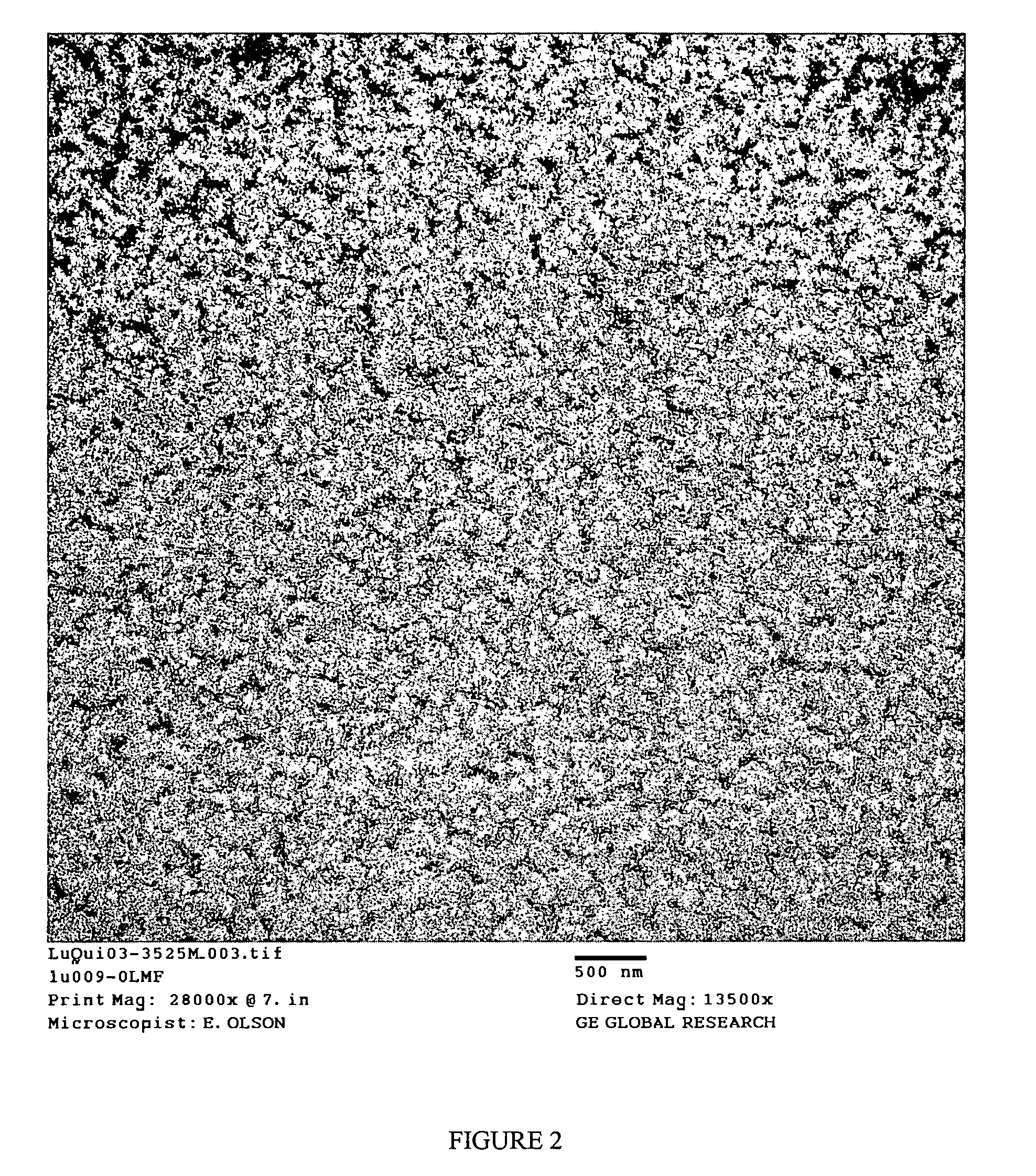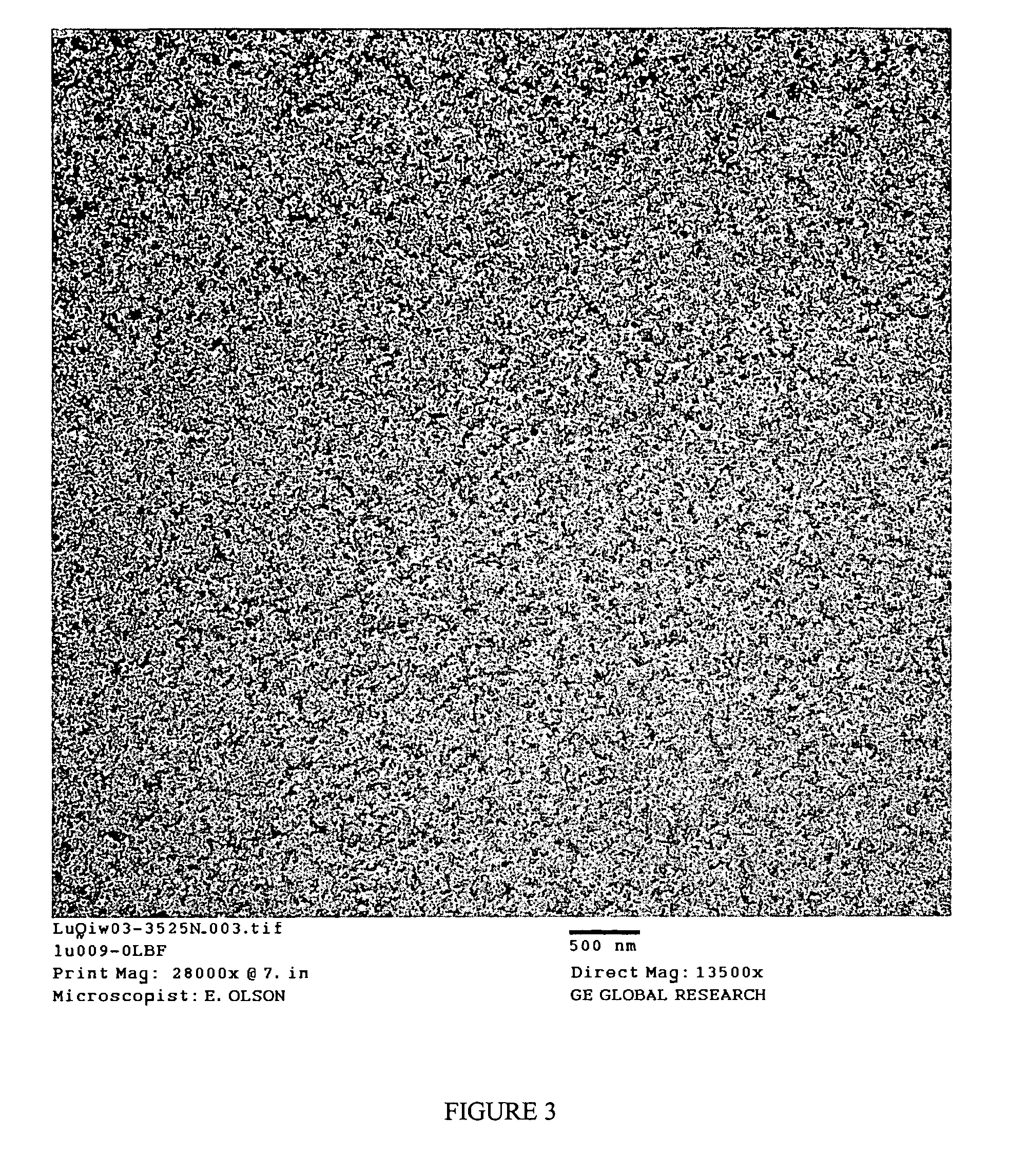Functionalized poly(arylene ether) composition and method
a technology of arylene ether and polymer, applied in the field of functionalized poly (arylene ether) composition and method, can solve the problem that existing formulations lack the balance of properties that is desired for fabricating plastic-packaged electronic devices, and achieve the effect of improving the balance of mold flow
- Summary
- Abstract
- Description
- Claims
- Application Information
AI Technical Summary
Benefits of technology
Problems solved by technology
Method used
Image
Examples
example 1
[0092]This example describes the preparation of a redistributed polyphenylene ether resin. To a three-necked flask were added poly(2,6-dimethyl-1,4-phenylene ether) (intrinsic viscosity=0.46 deciliters / gram (dL / g), 90 grams (g)), toluene (260 milliliters (mL)), and bisphenol A (5.4 g). The reaction mixture was heated to 90° C. to form a homogeneous solution. To the heated solution was added benzoyl peroxide (5.4 g) portion-wise. After the addition was complete, the reaction was maintained at 90° C. for about two hours. The solution was then cooled to room temperature and the product polyphenylene ether was precipitated from methanol. The resulting material contained 0.56 weight percent hydroxyl groups (as —OH). Hydroxyl end groups were measured by derivatization with a phosphorus reagent and quantification by 31P NMR, as described in K. P. Chan, D. S. Argyropoulos, D. M. White, G. W. Yeager and A. S. Hay, Macromolecules, 1994, volume 27, pages 6371 ff.
examples 2 – 9
EXAMPLES 2–9, COMPARATINE EXAMPLES 1 AND 2
[0093]Several redistributed poly(arylene ether) resins were prepared using the procedure of Example 1 and variations in the intrinsic viscosity of the poly(arylene ether) starting material, the concentration of bisphenol A, and the concentration of benzoyl peroxide. All reactions were run at 25 weight percent solids in toluene. One sample, Example 6, also used a modified work-up in which the sample was refluxed with pyrrolidine to remove any benzoate ester groups from the redistributed polyphenylene ether. After the reaction mixture was cooled to room temperature, the product was precipitated by combining one volume of the cooled reaction mixture with twice the volume of methanol. The precipitate was filtered and washed with additional methanol. Hydroxyl group content was determined as described above. Intrinsic viscosities were measured at 25° C. in chloroform. Number-average molecular weight (Mn) and weight-average molecular weight (Mw), b...
example 10
[0096]A redistributed polyphenylene ether was prepared as in Example 1, using as starting materials a poly(2,6-dimethyl-1,4-phenylene ether) (PPE) having an intrinsic viscosity of 0.41 dL / g and a hydroxyl content of 0.65 weight percent, 6 weight percent bisphenol A (based on PPE), and 6 weight percent benzoyl peroxide (based on PPE). The reaction mixture was refluxed with pyrrolidine (at 2.4 times the molar level of benzoyl peroxide) to remove any benzoate ester groups. The resulting redistributed PPE was methacrylate capped in a reaction using 362 g redistributed PPE, 362 g styrene, 5 g dimethylaminopyridine, and 65.2 g methacrylic anhydride. The methacrylate-capped polyphenylene ether product had a hydroxyl content less than the detection limit of 15 parts per million by weight.
PUM
| Property | Measurement | Unit |
|---|---|---|
| pressure | aaaaa | aaaaa |
| temperature | aaaaa | aaaaa |
| flexural strength | aaaaa | aaaaa |
Abstract
Description
Claims
Application Information
 Login to View More
Login to View More - R&D
- Intellectual Property
- Life Sciences
- Materials
- Tech Scout
- Unparalleled Data Quality
- Higher Quality Content
- 60% Fewer Hallucinations
Browse by: Latest US Patents, China's latest patents, Technical Efficacy Thesaurus, Application Domain, Technology Topic, Popular Technical Reports.
© 2025 PatSnap. All rights reserved.Legal|Privacy policy|Modern Slavery Act Transparency Statement|Sitemap|About US| Contact US: help@patsnap.com



